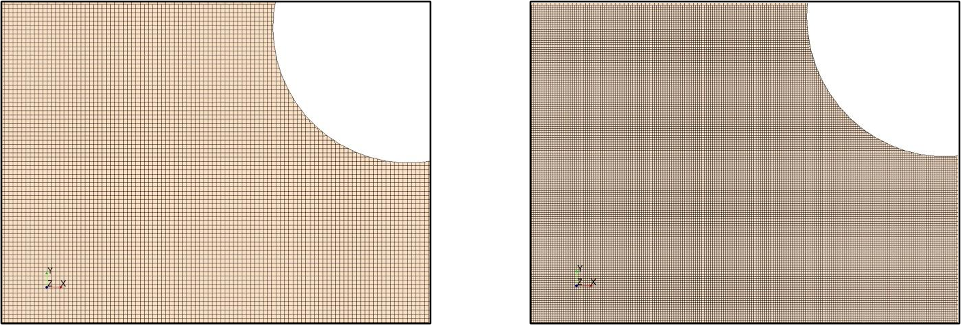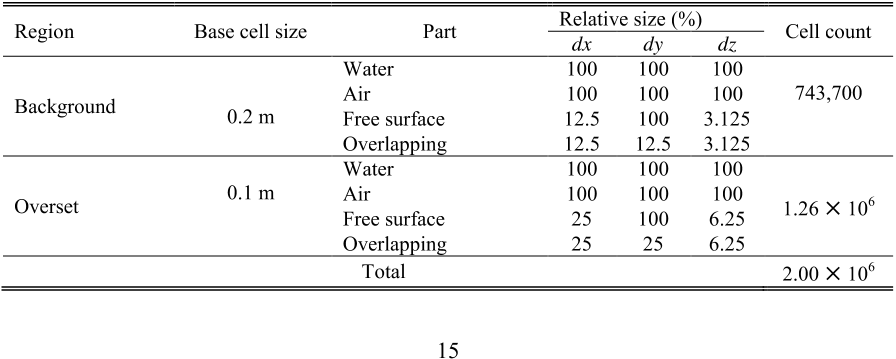
1
Wave-in-deck loads and response of a TLP model in unidirectional regular
waves
Nagi Abdussamie
a
, Yuriy Drobyshevski
a
, Roberto Ojeda
a
, Giles Thomas
b
, Walid Amin
a
a
National Centre for Maritime Engineering and Hydrodynamics
Australian Maritime College, University of Tasmania, Launceston, TAS 7250, Australia
b
Department of Mechanical Engineering, University College London, UK
Abstract
Model tests of a moored tension leg platform (TLP) subjected to cyclonic conditions
represented by deterministic regular waves were conducted with the aim of validating state-
of-the-art two phase numerical simulations of wave-in-deck impact events. Tendon tension
forces and localised slamming pressures at the deck underside were simultaneously measured
using repeated runs. The computational fluid dynamics (CFD) simulations were based on the
volume of fluid (VOF) method implemented in the commercial CFD code STAR-CCM+.
The TLP’s rigid body motions and the effect of tendons were simulated by means of an
overset grid and massless spring lines, respectively. The global response and tendon tensions
computed by the CFD code were found to be in good agreement with the measurements. The
aft tendons were found to experience slackness following the deck impact in many wave
cycles. CFD results showed that the downward component of the vertical wave-in-deck force
was approximately synchronised with the minimum tendon tensions and evidently caused
such slack situations. Although CFD simulations indicated that there was a strong interaction
between water and air phases at the moment of impact, the air compressibility did not show a
significant difference on the magnitude of impact pressures.
Keywords: tension leg platforms; wave-in-deck loads; dynamic response; numerical
simulations.
Manuscript - with full author details Click here to download Manuscript - with full author details
Manuscript.pdf

2
Introduction
Loads generated by extreme wave-in-deck events are one of the most important causes of
damage to fixed and floating offshore structures, especially in extreme storm conditions
(Kaiser et al., 2009, Abdussamie et al., 2014a, Forristall, 2007, Scharnke and Hennig, 2015,
Buchan et al., 1999, REUTERS, 2016). Offshore installations such as those located in the
Australian North West Shelf (NWS), Gulf of Mexico and the North Sea are exposed to
cyclones/hurricanes which can generate these severe wave events. For instance, Buchan et al.
(1999) reported on the impact of tropical cyclone Olivia on Australia’s NWS. The storm
caused significant damage to oil and gas facilities in the region. Another example of this is
the destruction of 126 offshore structures and the severe damage of 183 other structures
during the period 2004 – 2005 due to the hurricanes Ivan, Katrina and Rita in the Gulf of
Mexico (Kaiser et al., 2009). Most recently, in December 2015, living quarters of 50 workers
of an offshore drilling rig in the North Sea were damaged when an enormous wave hit the
accommodation block and left one person dead and two injured (REUTERS, 2016). Imparing
the safety of life and/or damage to structure or equipment can have costly economic and
safety implications. Consequently, there is a requirement by classification societies to ensure
that an offshore facility can survive in extreme wave conditions (Lee et al., 2014, ABS, 2014,
API, 2010, DNV, 2009). The slam events and the associated forces must be correctly and
accuratley accounted for in the design stage.
The current engineering knowledge required to accurately predict the magnitude and
distribution of wave-in-deck loads and the resulting global response of a floating structures
such tension leg platforms (TLPs) and semi-submersibles remains limited. This fact is
reflected in the very limited number of papers reporting on model tests and numerical
analyses of typical multi-column floaters currently available in the open literature.
Johannessen et al. (2006) and Hennig et al. (2011) investigated the dynamic air gap, wave

3
loads and floating platform response under extreme wave conditions. Both investigations
reported that a wave-in-deck event can lead to an additional extreme response mechanism
and a step change in the extreme loading magnitude. It must be noted that complete and
detailed results of these types of experiments are usually subjected to project confidentiality
requirements and are therefore not available in the public domain.
Model tests are arguably the best approach for estimating wave-in-deck loads (Scharnke et
al., 2014). However, this approach is costly, time-consuming and involves a number of
drawbacks such as scaling effects. Alternatively, the use of computational fluid dynamics
(CFD) based methods for calculating wave induced loads on offshore structures has been
increasing. Commonly used commercial codes such as STAR-CCM+ and ANSYS FLUENT
are available for modelling and solving wave-in-deck impact problems using the volume of
fluid (VOF) method to capture free-surface hydrodynamic flows (CD-Adapco, 2012, Fluent,
2009). Recently, a robust overset grid technique has been developed to allow for numerical
models with six degrees of freedom (6DOF) (Chen et al., 2008). Unlike traditional mesh
techniques such as dynamic mesh, the mesh in the overset grid technique does not defrom
and thereby remeshing is not required. The technique can therefore be used for modelling
large amplitude motions such as the case of the surge motion in TLPs. Nevertheless, any new
CFD simulation technique can only be trusted by the industry if its results have been
thoroughly validated against experimental data first.
There is a large body of work on CFD investigations of wave impact loads on fixed deck
structures (Abdussamie et al., 2014b, Birknes-Berg and Johannessen, 2015, Iwanowski et al.,
2014, Ren and Wang, 2004). However very little work on fixed with columns and floating
structures has been reported to date. Buchner and Bunnik (2007) employed an improved VOF
(iVOF) method implemented in ComFLOW for solving the dynamic response of the
SNORRE-A TLP subjected to extreme regular waves. Rudman and Cleary (2013) employed

4
the Smoothed Particle Hydrodynamics (SPH) technique to simulate the fully non-linear
dynamics of a large breaking wave hitting a TLP. These numerical studies (Buchner and
Bunnik, 2007, Rudman and Cleary, 2013) were not validated against model tests. Wu et al.
(2014) conducted a numerical study using STAR-CCM+ to investigate the air gap of a TLP
under irregular extreme waves by applying the same input wave signal used in the model test.
Each wave signal required 20 or more iterations in order to achieve a satisfactory match
between measurements and numercial results. This implies that their proposed CFD
technique is still too time expensive to be used for practical applications (Birknes-Berg and
Johannessen, 2015).
The literature review discussed above showed that there are no detailed, combined numerical-
experimental wave-in-deck investigations on floating offshore structures available for
scientific research in the public domain. Therefore, the objective of this study is to investigate
the problem in a systematic way by introducing both experimental and numerical procedures.
The scope of the present investigation is to examine the global response of a conventional
TLP at a model scale of 1:125 due to extreme wave events corresponding to a 10,000-year
cyclonic condition. Regular wave tests were conducted in the Australian Maritime College
(AMC) towing tank. Using data from repeated runs, uncertainity tests of wave elevations,
tendon tensions, surge motion and slam pressures at the deck underside were performed. In
addition, the commercial CFD code STAR-CCM+ was used to investigate the characteristics
of unidirectional regular wave impact on the model. The overset grid technique was used to
model rigid body motions. The TLP tendons were modelled using masless spring lines. The
numerical results were then validated against the measurements acquired in model tests.
Experimental investigation
Experimental setup
The TLP model was divided into two parts namely a hull module (columns and pontoons)
and a topside deck module. The TLP hull module was represented by four circular columns

5
and four square pontoons; the scaled model dimensions were based on the SNORRE-A TLP
(Almeland et al., 1991). The main principles of the structure are given in Table 1. A square
deck box of 608 mm 608 mm and 210 mm high was constructed (Figure 1). Previous
studies examined the deck individually and the deck and hull as a combined structure
(Abdussamie et al., 2016a, Abdussamie et al., 2016b). The operating scaled draft was
maintained and the resulting static deck clearance, i.e., the vertical distance from the still-
water level (SWL) to the deck underside, was 120 mm (15.0 m full scale), as given in Table
1. The 1:125 water depth does not represent the actual operational water depth of SNORRE-
A, this was due to the limitations imposed by the maximum operational water depth of the
towing tank of 1.5 m (Abdussamie et al., 2016a).
Table 1. Key principles for SNORRE-A TLP at full and model scales.
Parameter
Full scale
Tested model scale
Column diameter
25.00 m
200 mm
Pontoon size, height width
11.50 x 11.50 m
92 x 92 mm
Column spacing
76.00 m
608 mm
Column height
63.00 m
505 mm
Deck size, length breadth height
124.5 92.0 15.0 m
608 608 210 mm
Deck clearance, a
0
27.00 m
120 mm
Platform draft
38.125 m
305 mm
Displacement
101840 t
52.15 kg
Total mass
77640 t
39.75 kg
Initial pretension per leg, T
o
6055 t
3.10 kg
Number of tendons per leg, n
4
1
Total tendon length at zero offset, L
o
307 m
1195 mm
Axial stiffness per leg, nEA/L
o
2.42 10
8
N/m
15.80 N/mm
Riser tension
3320 t
1.70 kg
Centre of gravity, C
g
(x, y, z)
n/a
(0.0, 0.0, 5.0) mm
Mass moment of inertia (I
xx,
I
yy,
I
zz
)
n/a
(5.23, 5.23, 5.63) kg.m
2
Water depth
310.00 m
1500 mm
Figure 1.
The rotation point of the tendons at the TLP model end was located at the column base. For
that purpose a hinge was installed for each column at z = -310 mm, i.e., the model’s keel





